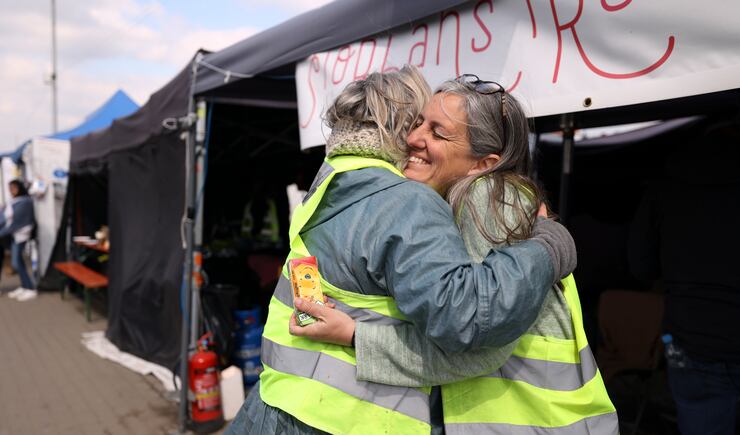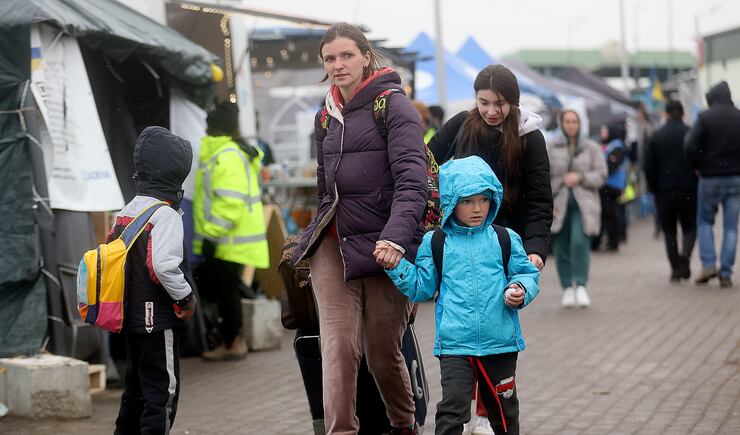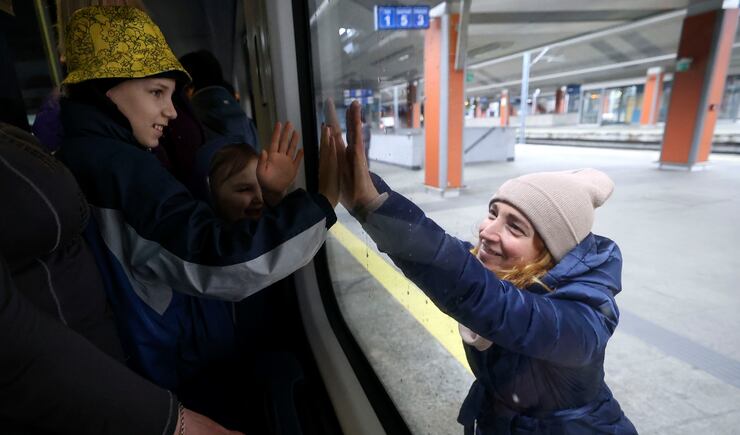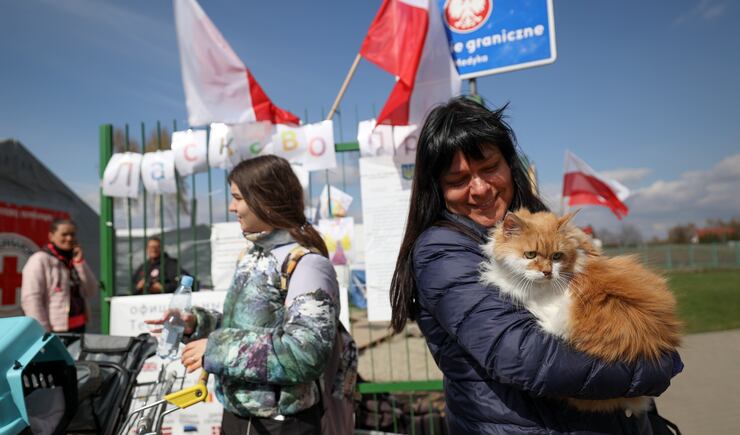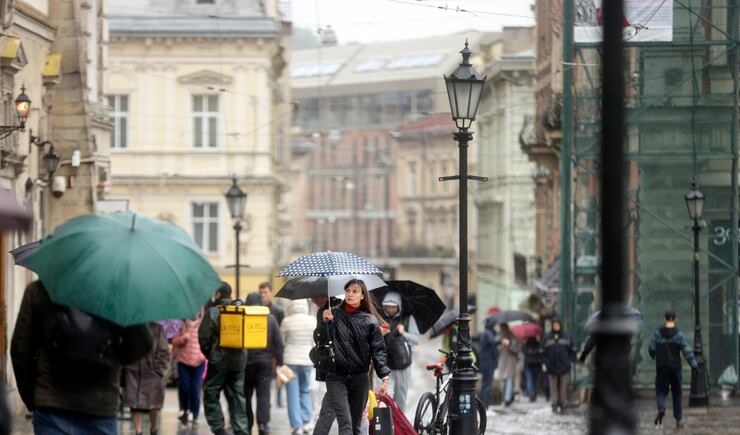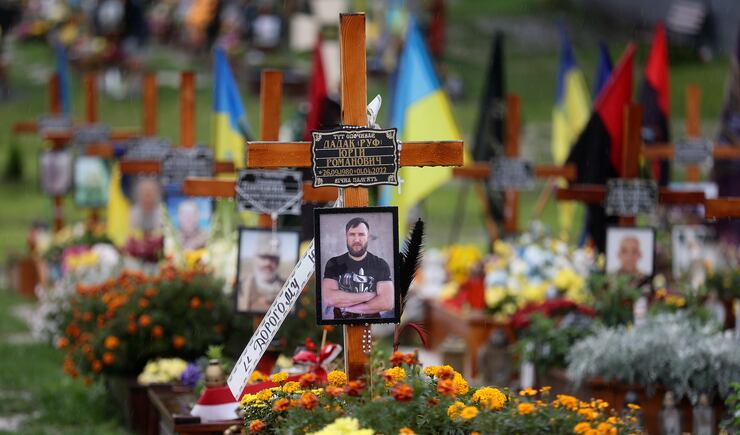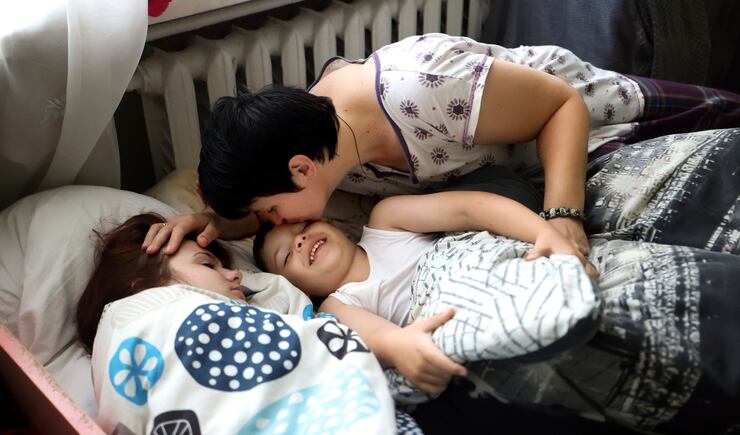The stream of refugees lasted through the day and into the night. By midnight, there were still groups walking across the border.
They were infants, toddlers, teenagers, mothers and grandmothers. Most were women, but there were men among the crowd, likely exempt from conscription because of age, health issues or their large family. Some were in wheelchairs, sobbing when they crossed the border into Poland. Others rejoiced. “It’s safe here,” one woman exclaimed with a frazzled smile.
They rolled their suitcases, wore backpacks and carried canvas bags full of belongings. Many had pets, with cats in crates or dogs by the leash. Some pushed shopping carts filled with random belongings, hastily packed away.
It was April 2022, and Russia’s invasion of Ukraine was little more than a month underway. Russia had just pulled out of the suburbs of Kyiv to focus on the country’s eastern front, leaving a path of destruction and war crimes in its path. Mariupol, once a vibrant, coastal city, was surrounded, and in a matter of months it would fall completely into Russian hands.
Friday marks one year since the invasion, a major escalation in the yearslong conflict simmering along Ukraine’s eastern border. The war has displaced millions — there are currently 8,075,440 refugees from Ukraine living in Europe. And almost 125,000 have applied to the U.S. sponsorship program Uniting for Ukraine, which allows residents to sponsor Ukrainian refugees. An unknown number are internally displaced, the United Nations’ estimate hovering around 5.3 million as of January. At least 8,000 civilians have perished, although international organizations say the real death toll is likely higher. And roughly 300,000 soldiers have died — about 100,000 Ukrainian, and 180,000 Russian, The New York Times recently reported.
At one point, nearly 11,000 refugees passed through the small, border village of Medyka, Poland, where the Deseret News reported from in April.
“My apartment is damaged. It’s finished,” said Anzhela Kumurxhi, a Mariupol resident, who for weeks lived in a basement as her neighborhood was bombed relentlessly. In April, when she was asked where she was headed, she smiled: “America, Russia, Africa? Any country. Just far from this hell.”
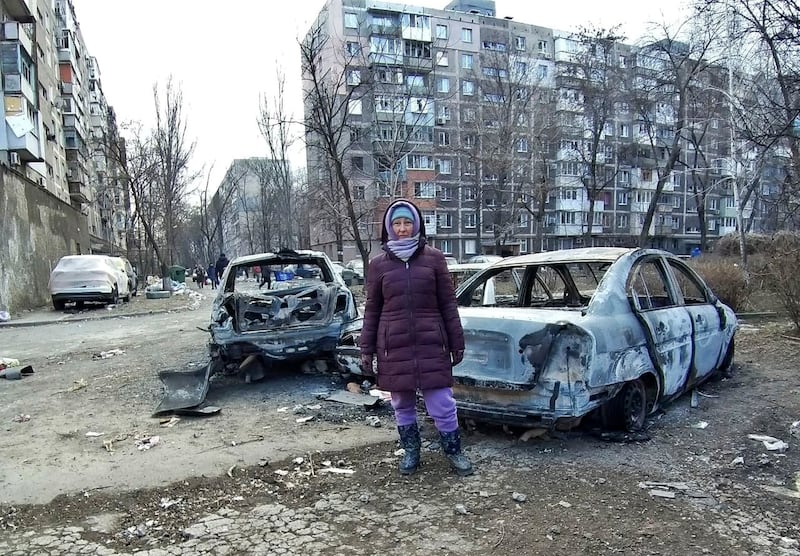
Kumurxhi now lives in Prescott, Arizona, one of the thousands of Ukrainians who found a sponsor and resettled in the U.S. She starts English classes in a few weeks, and hopes to obtain a driver’s license. She worked in a beauty salon in Ukraine, but now isn’t sure what job she wants to pursue. She thinks of Mariupol often.
“When I sleep at night, maybe five times a week, I see Mariupol. I am in Mariupol, and I am shocked from the destroyed buildings, the destroyed city,” she said. “... Of course I want to go back to Ukraine, but Mariupol (is) not Ukraine anymore.”
For Kumurxhi, the anniversary of the Russian invasion is an emotional one.
“I feel like it’s not real,” she says. “I was in the war only months ago.”
Kumurxhi caught up with the Deseret News Wednesday, as the future of the war in Ukraine remains uncertain. President Joe Biden recently made a historic visit to Kyiv, where he announced a half-billion dollars in new military aid, the latest package slated for Ukraine in a policy that’s increasingly unpopular at home.
“The fact that Putin is an evil, megalomaniacal despot doesn’t make the war between Ukraine & Russia ours to fight,” Utah Republican Sen. Mike Lee recently tweeted. His colleague Sen. Mitt Romney, in a visit to the Utah Legislature this week, acknowledged the Republican Party’s divide on backing Ukraine and reiterated has stance that the U.S. continue its support.
“We stand for liberty,” Romney said. “I think a lot of people don’t recognize that we agreed to defend Ukraine when Ukraine agreed to give up their nuclear weapons some years ago. We signed an agreement that we would help support Ukraine defend its sovereignty. That’s important to remember.”
Meanwhile, Russia continues to further diplomatic relations with China, with Russian President Vladimir Putin suspending the country’s involvement in the New START treaty, the last remaining nuclear treaty between the Kremlin and Washington, D.C.
And through it all the brutal war continues to take its toll, with front-line regions like Bakhmut described as a “meat grinder.”
Kumurxhi was granted humanitarian parole, which under the Biden administration’s program, gives Ukrainians 18 months of legal status in the U.S. Now, as the war shows no sign of stopping, time is running out for Ukrainians living in the U.S. Many, Kumurxhi included, don’t have a home to return to.
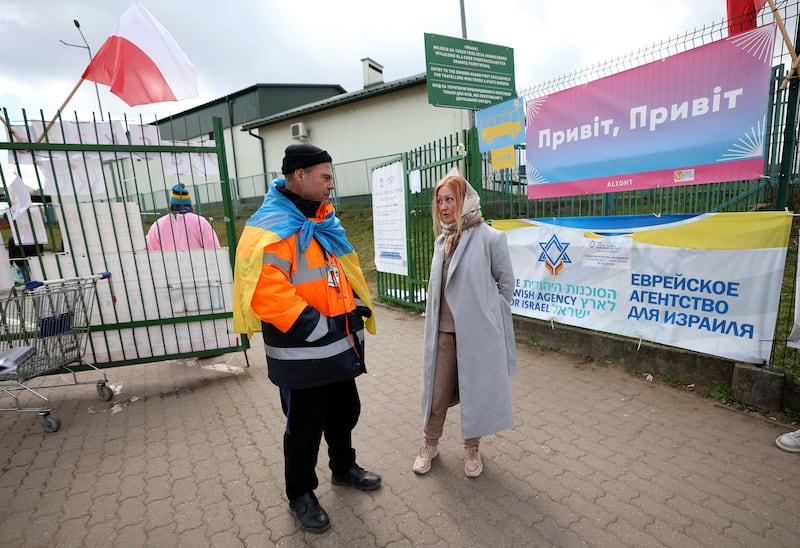
“We’re going into the second year. So that means that 18 months is going to run out,” said Faith Cooper, the International Rescue Committee’s regional director for U.S. South, which includes the U.S.-Mexico border.
Uniting for Ukraine was lauded as a success by immigration advocates — Cooper says it could be a model extended to refugees from around the world. But its limitations are starting to cause anxiety among recipients and advocates alike.
The International Rescue Committee is one of several groups calling on the Biden administration to extend work authorization and temporary status for Ukrainians.
“Congress and the Biden administration must step up efforts to offer permanence to resettled Afghans and Ukrainians,” said Jennie Murray, president and CEO of the National Immigration Forum, in a news release. “No one should wonder whether they could be forced to return to countries where danger remains imminent, and displacement is likely to continue.”
Cooper also would like to see the funding for Uniting for Ukraine extended to cover legal services for applicants, who often find themselves lost in the country’s confusing immigration system.
“We know more and more innocent civilians are paying the highest price and continuing to flee their homes,” she said. “While the majority are headed to Europe, we are also going to see an uptick in the numbers coming to the U.S.”
When Kumurxhi first spoke with the Deseret News last April, she had been traveling for months. Russian troops evacuated her apartment in Mariupol, forcing Kumurxhi and her mother onto a bus that took them to a Russian occupied village in Ukraine. Several days later, they were transported to the Russian border, where the refugees underwent a more thorough, invasive evaluation. Soldiers checked their phones, tattoos, their clothing. The men were interrogated for hours.
What followed was a 28-hour train ride to the Russian city of Tula. Again the refugees were inspected, though this time the Ukrainians were sorted into two groups — those destined for filtration camps, and those free to go.
Kumurxhi, then sick with the flu, had a sister in Moscow, and was not sent to a camp.
With help from ordinary Russian citizens — many of whom she says were secretly opposed to the war in Ukraine — Kumurxhi was able to take a bus to Estonia, then eventually Poland.
She now lives in an apartment outside Prescott. Still, thousands of miles removed from the front lines, Kumurxhi fights her own war.
“I still don’t understand where I am, what I should do,” she said. “People ask me, where (do) you want to work? I didn’t have an answer, because I haven’t found myself.”

